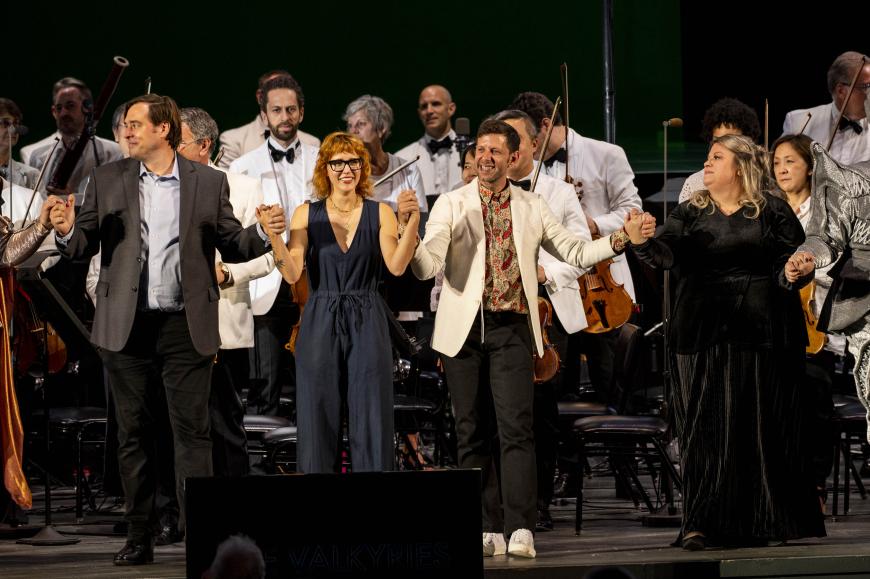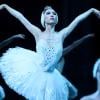
No stranger to alien landscapes, it was the glowing face of Sigourney Weaver that greeted the audience Sunday for a performance of Act 3 of Richard Wagner’s Die Walküre at the Hollywood Bowl — a performance, she informed us, where Wagner’s Norse gods reside in their own digital quadrant of the metaverse.
The highly anticipated concert featured the full force of the Los Angeles Philharmonic (including five harps) conducted by Gustavo Dudamel, with a top-flight vocal cast ruled over by Matthias Goerne as the vengeful god Wotan, Christine Goerke as his disobedient warrior daughter Brünnhilde, and Amber Wagner as the long-suffering Sieglinde.
But it was the production’s visual elements and direction by Yuval Sharon that everyone was waiting for. The advance buzz promised a cinematic take worthy of Hollywood, with singers performing in front of a green screen capable of transporting them to a galaxy far, far away. Could this, perhaps, be the first stage of a sci-fi Ring of the Nibelung collaboration between Dudamel and Sharon, destined for Paris or for Detroit Opera, Sharon’s current home base? If so, based on Sunday’s performance, it is light years away from a successful visualization.

It’s not the first time a Hollywood-style “Star Wars” Ring has been proposed. In 2000, LA Opera embarked on a collaboration with Lucasfilm to create just such a thing. Fascinating renderings of the sets and a video of lightsaber-wielding Valkyries still exist. Ultimately, the tab proved way beyond the company’s means, and the project was abandoned. As a more cost-effective alternative, LA Opera imported the German iconoclastic visual artist/director Achim Freyer. That Ring, which was presented in full in 2010, was such a critical and financial disaster it nearly bankrupted the company. The connection to Sunday’s “Ride of the Valkyries” at the Hollywood Bowl is that the young assistant who came from Europe to work alongside Freyer was Yuval Sharon.
As we well know, advances in artificial intelligence and digital technology have made the metaverse the new go-to destination. But for some reason (probably budgetary), instead of going state-of-the-art (a la Spider-Man), Sharon and his collaborators (stage and screen designers Kaitlyn Pietras, Jason H. Thompson, Andrea Carver, Eli McCaffrey, and Derek Christiansen) decided to go retro with a vengeance. Instead of a dazzling metaverse, we got a popsicle-colored digital landscape of primitive video game graphics, with motorcycle-riding Valkyries downloaded from the original 1982 version of Tron. It didn’t help that the puffy gold lamé, tuck-and-roll costumes (by Suzanne Hanna and Carlos Soto) looked like they came from Flash Gordon or Forbidden Planet.

Thankfully, there was an alternate reality to escape to — the musical performance. From the first rising crescendo announcing the arrival of the Valkyries to the multi-harp glitter of the “Magic Fire Music,” this rendition (despite the eccentricities of the Bowl’s acoustics) was at the highest level, modulated skillfully by Dudamel and the combined forces of the vocal ensemble. You could not ask for a more harmonically copacetic motorcycle gang of Valkyries than Tamara Mumford, Ronnita Miller, Deborah Nansteel, Jessica Faselt, Alexandria Shiner, Laura Wilde, Laura Krumm, and Renée Tatum.
But the dramatic heart of Act 3 unquestionably belonged to Goerne and Goerke and their tempestuous clash of personalities. Ironically, it was in the quiet moments, when Wagner has the orchestra recede into the background, that the emotional magic happened — when Goerke’s Brünnhilde made her impassioned plea and Goerne’s Wotan allowed his bluster to drop and opened his heart to the love he feels for his daughter. No goofy graphics or too close close-ups could diminish the power of those moments.
With four full rehearsals, including one for the orchestra and singers at Disney Hall, everyone’s coordination was consistently impressive. And when orchestral fireworks were called for, Dudamel and the LA Phil rocked the Bowl. The power of Wagner’s myth, so expertly performed, slipped past the metaverse, rendering it pallid and uninteresting by comparison.




